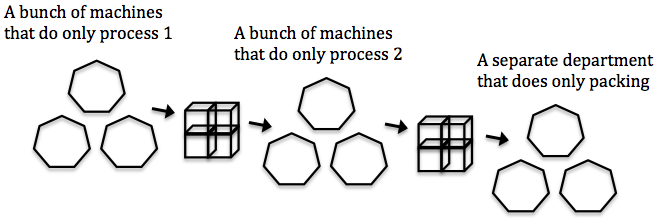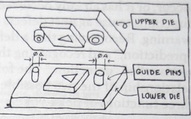I bet you are tired or hearing your Chinese suppliers say “this is made by hand, so avoiding defects is impossible”.
So am I, because it’s 100% wrong.
Some small factories have decreased their defect rate below 50 parts per million (that’s 0.005%). One of them, in Japan, employs housewives in the countryside, and their operations are all manual!
So, how do they get so close to zero defects? The answer is by applying simple “lean” principles.
1. What is “lean manufacturing”?
Lean is a set of principles and tools that have been systematized by Toyota, and that have been applied to many different types of products and production processes over the last 20 years.
Lean can not only be found in Japan but it is now widely used throughout the US, India, Europe, and China.
Less than 1% of companies are truly “lean”, but many others are applying some lean principles and tools.
Americans call it “lean” because it uses less labor, less material, less time, and less space to produce a given batch with fewer defects, when compared to traditional manufacturing methodologies.
It is the best way to achieve extremely high levels of quality with manual processes.
2. Faster production cycles help improve quality
Many factories that have implemented lean have managed to reduce their cycle time (the time between starting a production run and getting some finished products) by 80% – 90%.
To simplify what happens, they get from this…
To this…
This is the best way to avoid widespread quality problems.
Why? Because finished products can be inspected/tested a few hours (maximum) after a production is launched, and the root cause(s) of a defect is much easier to find – the production batch is probably still work-in-process and “the trail is still hot”, as they say.
In contrast to that, I have seen many Chinese factories discover a widespread problem with a production batch after maybe thousands of pieces had already passed through the faulty process. The trouble here is that because the production batch would have already been completed there would be no way of identifying where the root cause of the problem took place.
3. Strong discipline improves adherence to standards
Putting a system in place is not the hard part, especially when ISO 9001-compliant quality systems are available in bookstores and are (supposedly) ready to be used.
It doesn’t take months of work to place work instructions as well as photos of good and bad samples at each work station.
The hard part is training, coaching, and enforcement. There is no substitute for managers walking the shop floor every day and checking what the production staffs are doing.
What Chinese Managers tend to do however, is stay in their air-conditioned offices or meeting rooms. This lack of presence on the factory floor is quite unfortunate from both the factory’s and the buyer’s point of view.
When I first walk in a factory, I carry out this simple 2-minute 3 point test:
- Does the place seem to be in order? Do the operators wear appropriate clothes and protective equipment?
- Are there QC records at each process, and are they filled out regularly?
- If I ask them to describe and explain the changes that had been made to one of their controlled procedures over the last month, do they need to “go and check” first?
If the answers to points 1 and 2 are YES and the point 3 can be answered straight away, it tells me that there is some sort of structure and process that is being followed which is a positive sign.
4. The necessity for self-inspection
By self-inspection I mean the operators themselves do most of the quality control.
I don’t mean each worker should evaluate their own work – they lack the objectivity necessary for that.
The key is in successive inspection: I grab the part, I check it, I process it, and I put it down.
Here are the 3 basic principles that every worker MUST adhere to:
- We do not accept bad work
- We do not do bad work
- We do not pass on bad work
Does it conflict with the piece rate so commonly applied in China? Yes, sure, but compensation structures can be changed.
Does it take more time for the operators to do these checks? Yes is can. And that’s a problem when a tough deadline needs to be met: operators might “exceptionally” choose to suspend self-inspection.
Fortunately, this extra time can be greatly reduced–and sometimes eliminated entirely–if you get creative, as we’ll see in next part.
5. The magic of mistake proofing and usability engineering
On your computer, have you ever inserted a cable (for example the power cord) in a wrong hole? It is impossible because they all have different shapes and sizes.
Some PC manufacturers have even color-coded the cables and the corresponding holes. Strictly speaking, that’s not mistake proofing because it does not always prevent mistakes. That’s usability engineering. But it still brings tremendous value.
Does it cost a lot of money? No. Is it effective? Yes!
Now, have you seen this type of thinking applied by a Chinese manufacturer?
- Would they think of asking the designer to make the holes different shapes/sizes? Probably not.
- Would they think of color-coding each hole and each cable? The probability is even lower.
Some manufacturers in Japan and in the West have become masters at mistake-proofing. You can find 240 pages of real examples that were implemented in factory settings here.
Here is a simple example (guide pins of different sizes, in a set of fixtures):
From experience, the 5 pieces of advice I listed above are those that make the biggest difference in a manufacturer’s quality level. That’s the philosophy we try to follow at China Manufacturing Consultants.
And the beauty is… It does not require any capital investment. Forget about automation, keep the same people, and show them how to work smarter!




Leave a Reply